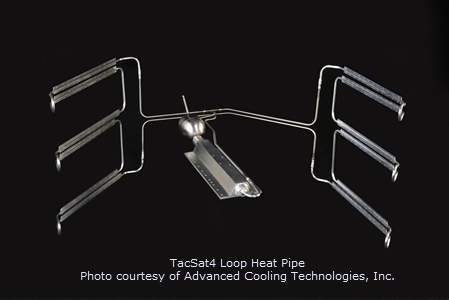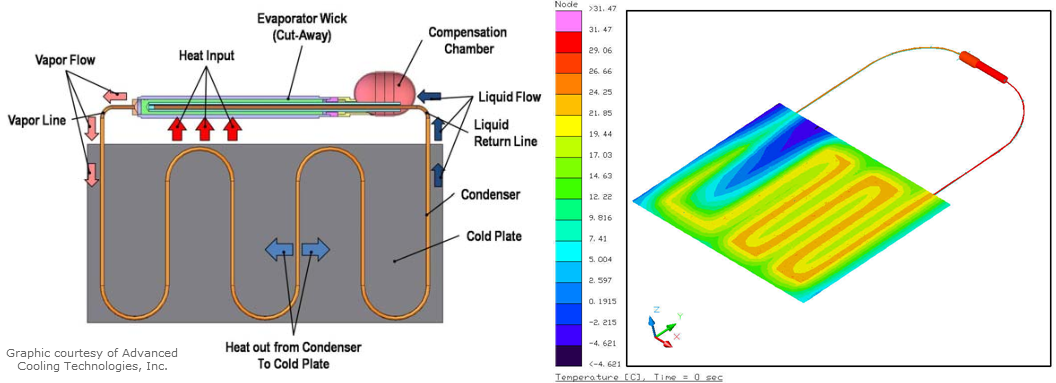Modeling Loop Heat Pipes and other Capillary Devices
 The methods for modeling LHPs and capillary pumped loops (CPLs) are very different from those used to model heat pipes. Unlike a heat pipe, self-pumping loops require full thermohydraulic modeling of the fluid and the thermal-structural environment. In addition to supporting the modeling of single-phase pumped loops, SINDA/FLUINT and FloCAD® have several features which make them uniquely capable of modeling two-phase pumped loops and capillary pumped pumps. Using SINDA/FLUINT and FloCAD, you can capture everything from the system-level effects of the LHP all the way down to detailed thermodynamic and hydrodynamic transient events such as LHP start-up, compensation chamber (reservoir) quenching, partially primed wicks, and pressure and flow oscillations.
The methods for modeling LHPs and capillary pumped loops (CPLs) are very different from those used to model heat pipes. Unlike a heat pipe, self-pumping loops require full thermohydraulic modeling of the fluid and the thermal-structural environment. In addition to supporting the modeling of single-phase pumped loops, SINDA/FLUINT and FloCAD® have several features which make them uniquely capable of modeling two-phase pumped loops and capillary pumped pumps. Using SINDA/FLUINT and FloCAD, you can capture everything from the system-level effects of the LHP all the way down to detailed thermodynamic and hydrodynamic transient events such as LHP start-up, compensation chamber (reservoir) quenching, partially primed wicks, and pressure and flow oscillations.
When it comes to modeling two-phase loops, SINDA/FLUINT has the unique advantage over other fluid flow codes in that a portion of the software development team (engineers by training) were actively involved in the development of CPLs and LHPs during the late 1980s and 1990s, while they were also working on the development of SINDA/FLUINT. Consequently, when obstacles were encountered in the process of modeling these two-phase loops, new features were added to the software to overcome previous simulation limitations. Such features include interface elements ("IFACEs") for modeling compensation chamber and the liquid/vapor interface within the wick, a capillary evaporator pump, and a capillary device to model wicks, grooves, tubules, and so forth. During this time period, the ability to model lack of thermal equilibrium within the compensation chamber was also added to better estimate start-up responses.
Unique features relevant for analyzing LHPs and CPLs
- Complete thermodynamics: phases appear and disappear as conditions warrant
- Capillary modeling tools for static or vaporizing wicks
- Vapor trapping (up to the bubble point) in capillary devices
- Capillary flow regulators (constant back-pressure devices used in parallel condensers)
- From top-level steady-state evaporator-pump modeling to detailed tracking of unsteady liquid/vapor interfaces within wicks
- Full phasic nonequilibrium two-fluid modeling for unsteady hydrodynamics in LHP compensation chambers
- Two-phase heat transfer correlations built-in or user-defined
- Two-phase pressure drop correlations built-in or user-defined
- Automatic flow regime mapping
- Homogeneous and slip flow modeling, including countercurrent flow in the presence of gravity and other accelerations
- Conservation of total charge mass for accurate pressure predictions in transients or parametric studies
- Complex liquid/gas mixtures including optional dissolution of any gaseous solute into liquids
- Fast and easy geometric model generation of condensers (serpentine, manifolded, etc.), including bonding or contact to thermal surfaces and solids, using Thermal Desktop.

Resources
-
Four-part LHP Webinar Series:
- Overview of LHPs
- Introduction to LHP Modeling (System-level)
- Wick Back-conduction
- Advanced LHP Modeling (detailed-level, transients, gravity assist)
Please visit our support forum for a sample of how to model an LHP, or for an advanced example.
Publications
- Steady State and Transient Loop Heat Pipe Modeling (ICES 2000)
- Noncondensible Gas, Mass, and Adverse Tilt Effects on the Start-up of Loop Heat Pipes (ICES 1999)
- Modeling Transient Operation of Loop Heat Pipes using Thermal Desktop, Dmitry Khrustalev, ATK Space (TFAWS 2007)
- Viability of Loop Heat Pipes for Space Solar Power Applications (AIAA 2001)
- Development of Cryogenic Capillary Pumped Loop (IECEC 1998)
- Stabilized Loop Heat Pipe Architecture for Reliable Operation Under High-Power Transients (JTHT 2020)
